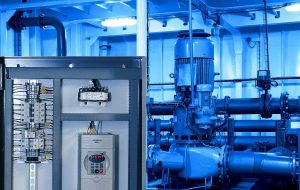Variable Frequency Drives
Variable frequency drives are commonly used in industrial production systems to control the speed of fans and pumps. They offer many benefits, including energy savings, lower maintenance costs, and reduced equipment downtime.
A VFD converts DC power from the DC bus into AC power that can drive a motor. It then applies a voltage adjustment to the AC output. This changes the AC current into a quasi-sinusoidal waveform that is suitable for the motor. The drive can also include a capacitor or other circuits to remove the ac ripple on the DC bus, resulting in a clean, almost-sinusoidal dc output.

The most common application of a variable frequency drives is to save energy by running a fan or pump at the exact speed needed for a given system demand. This can reduce the overall energy consumption of a system by up to 30%, saving money and reducing carbon footprint.
Benefits of Variable Frequency Drives
Another benefit is that a VFD can eliminate mechanical shock of starting or stopping loads by smoothing acceleration and deceleration cycles. This extends the lifetime of belts, bearings and gears, which can dramatically reduce maintenance costs and downtime. It also helps to reduce or eliminate water hammering in pipes and hydraulic installations.
VFDs can be programmed to automatically detect and respond to a wide range of fault conditions. This can greatly reduce downtime and maintain constant operation for important industrial processes such as food manufacturing or oil refining. Many VFDs include auto reset capabilities to address nuisance faults that can trigger the drive to shut down the process.
Many drives are designed to operate with multiple inputs to allow them to be easily adjusted for the specific needs of each application. These inputs can be digital (contacts or relays), analog (0-10 V dc or +/-10 V dc), 4-20 mA, or PLC signals.
VFDs are natural soft starters, allowing them to reduce inrush current when starting and stopping motors. They can also adjust the acceleration and deceleration rates based on operating conditions or specific commands. Aggressive acceleration and deceleration rates can overtax the drive and cause overload or overcurrent faults.
A common problem encountered by drive installers is setting the run command and speed reference on the drive. This can be complicated by the fact that different drives are configured to operate from a variety of input sources.
A VFD with an automatic zero current shutdown, or ACV, is a great choice for sensitive electrical applications such as data centers or hospitals. The ACV feature provides an additional layer of protection against surges and transients entering the data center. This feature can be easily turned on or off through a local keypad, or through the drives graphical interface. In addition, an ACV-equipped drive can be configured to minimize harmonics and provide high power factor on the line side of the transformer, avoiding the need for costly harmonic filters at the distribution transformer or substation.